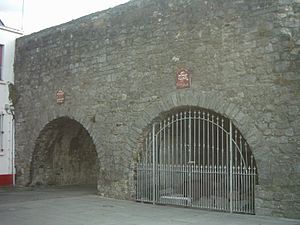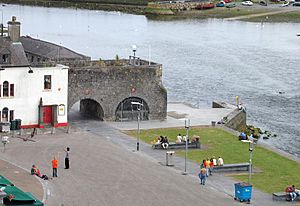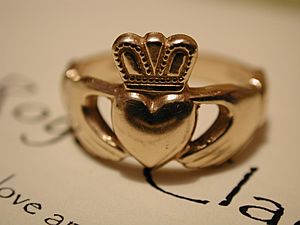Galway City Museum facts for kids
 |
|
| Established | 2006 |
|---|---|
| Location | Spanish Arch, Galway, Ireland |
| Type | Local Authority Museum |
| Visitors | 161,558 (2011) |
The Galway City Museum (called Músaem Cathrach na Gaillimhe in Irish) is a fun place to learn about the history of Galway City in Ireland. It opened its doors on July 29, 2006. You can find it right next to the famous Spanish Arch.
Contents
History of the Museum
How the Museum Started
The Galway City Museum first opened in 1976. It was located in a building called Comerford House. Before the museum moved in, this house was home to a famous artist named Clare Sheridan. The museum began with a small collection of old medieval stones from the city, which Sheridan had gathered. Over time, the museum grew. It started to collect items about everyday life, old industries, and military history.
Comerford House: A Special Building
Comerford House is a very old building, built around 1800. It was given to the Galway City Council by the Comerford family. They wanted it to be used for the community. Clare Consuelo Sheridan, a sculptor and writer, lived there from 1948 to 1954. She was even a cousin of Sir Winston Churchill! After being used for city offices, Comerford House became the first home of the Galway City Museum in 1976. This first museum closed in 2004.
A Brand New Museum Building
In April 2007, a new, specially built museum opened. It was built right behind the old Comerford House. The new Galway City Museum was a big project by the Galway City Council. They wanted to improve the cultural life of Galway. The building was designed by architects Ciaran O’Connor and Ger Harvey.
The new museum is located right by the River Corrib and the Spanish Arch. The Spanish Arch is a very old monument that was once part of the city's defensive wall. The museum's design created a public space, like a town square, between the museum and the Spanish Arch. This area is sometimes used for city events.
The museum building has an 'L' shape and is three stories tall. This helps it fit in with the other buildings nearby. The project finished in 2006. It created a large space of 2,100 square meters. The architects even won an award for their design in 2006!
What You Can See at the Museum
The Galway City Museum collects and shows items about Galway City's history. This includes things about Archaeology, Art, Geology, Natural History, and how people lived. The museum started with medieval stones. Over the years, it grew to include items about daily life, industries, and military history.
When the new building opened in 2007, it brought together all the old collections from Comerford House. It also added new items. Most of the museum's collection comes from the Comerford House days. This collection has almost 1,000 objects. They cover many different time periods and were gathered over about thirty years.
Permanent Collections
The museum has many interesting permanent collections:
- DJ Murphy Collection: This collection has over three hundred farm tools and industrial items. Most of them are from Galway County. It also includes some rare items made of straw, showing traditional Irish country life.
- Medieval Stone Collection: You can see many old stone carvings and parts of buildings here. They are mostly from the 16th and 17th centuries in Galway City. This includes old fireplaces, stone supports (called corbels), and family crests (called armorial plaques and heraldic panels). Many of these pieces come from buildings that no longer exist. They are linked to the famous families of the Tribes of Galway.
- Galway Militia Artefacts: These are objects related to the Connaught Rangers. They belonged to people from Galway who fought in different wars. This includes wars like the Crimea War and the First and Second World Wars.
- Claddagh Collection: This collection tells the story of the Claddagh, a famous fishing village in Galway. It includes the special apron and shawl worn by people from Claddagh. There's also a model showing how the Claddagh village looked in the early 1900s.
- Maritime Collection: Here you can see different fishing boats and navigation books. There's also an Aldis lamp (used for signaling) and the boat-building tools of John Reney. Reney was known as the last boat builder from the Claddagh. His boatyard was once right next to where the new museum stands.
- 19th and 20th Century Galway: This collection shows objects from shops, public houses (pubs), and businesses in Galway from the 1800s and 1900s. It includes items from Persse's Whiskey Distillery and Young's Hibernian Mineral Water Works.
- Derek Biddulph Photographic Collection: This is a series of photographs by Galway artist Derek Biddulph. They show the city from the 1950s onwards.
- Art Collection: This includes a painting called Tiger Lillies and a carving of the Madonna and Child by artist Clare Sheridan. She used to live in Comerford House, the museum's first home. There's also a painting by Cecil Maguire.
In total, the permanent collection has about 1,000 items.
Special Items on Loan
Besides its own collection, the Galway City Museum also displays items borrowed from other places:
- Civic Collection: This includes the Civic Sword and Mace. The sword dates back to 1610. It allowed the mayor to carry such a weapon. The mace was made in Dublin in 1710 and given to Galway in 1712.
- The Daly Collection: This collection has twenty-four paintings and four sculptures. They are on loan to the Galway City Council. It includes works by famous artists like John Constable, Paul Henry, and Jack Butler Yeats.
- A rare copy of a 1651 map of Galway.
- A statue of Pádraic Ó Conaire (1882–1928), carved by Albert Power. This statue used to be in Eyre Square in Galway.
- The Royal Arms of George III, from the early 1800s. It used to be in the Town Court House, which is now the Town Hall Theatre.
- National Museum of Ireland: This loan includes objects from the Galway City Excavations Project (1987–98). You can see old coins, pottery, wine bottles, and artillery items like cannonballs.
- Dominican Order of Nuns, Galway: This collection has church silverware and textiles from the 1700s. It includes chalices (cups used in church), candlesticks, and a special box for holy bread. There's also a reliquary casket of St. Ursula. It was made by Richard Joyce. Many people believe Joyce was the original designer of the Claddagh ring.
- Sisters of Mercy, Galway: This includes a chalice and a patton (a plate for holy bread) from the 1600s. There's also silver cutlery from the 1800s. This cutlery was given to the nuns by Fr. Daly. He was a well-known person in Galway in the 1800s.
In total, the museum has about 90 items on loan.
Exhibitions to Explore
The museum offers both permanent and temporary exhibitions. Permanent exhibitions include:
- Routes to the Past (about Pre-Historic Galway)
- Galway Within the Walls (about Medieval Galway)
- Pádraic Ó Conaire: Man and Statue
- Dance Hall Days
- Cinema in Galway
- Galway and the Wars of Empire
Temporary exhibitions have featured works by artists like Jack B. Yeats. They also cover topics like Between Art and Industry and Uisce agus Bheatha/ Water and Life, which explored the history of people, places, boats, and water.
National Museum Status
In February 2010, the Galway City Museum received a special status. It was recognized under the National Cultural Institutions Act of 1997. This means it joined eleven other local museums in Ireland with this honor. This special status allows the museum to keep important archaeological objects for the Irish State.
Images for kids






